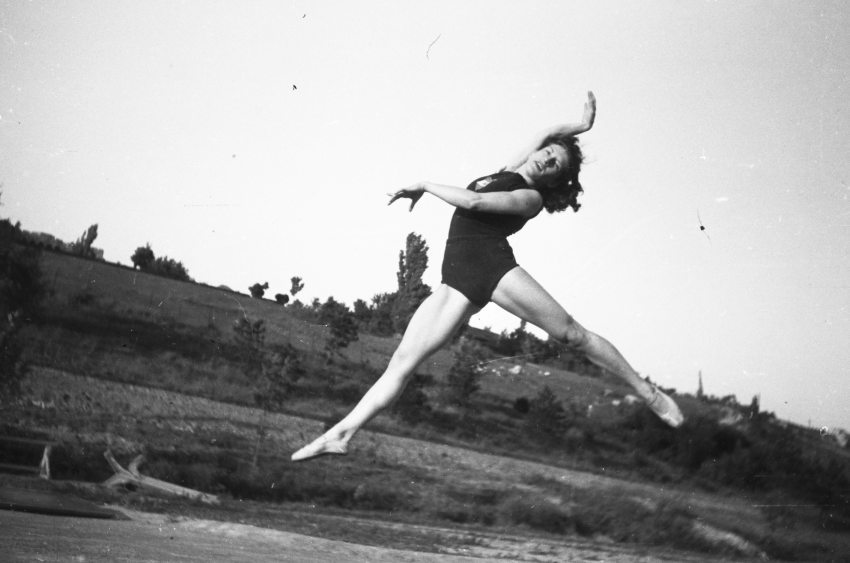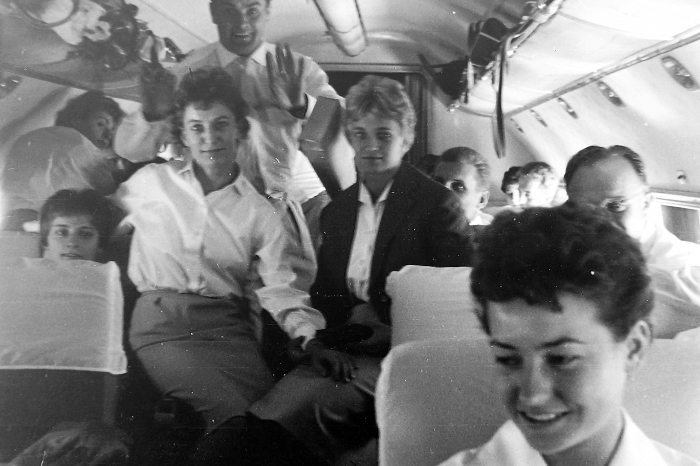1956 ruined sporting stars, and let plenty of talent out of the country
The Hungarian women's gymnastics team was at the height of an astonishing run of success when news came of the crushing of the 1956 revolution. They won silver in London (1948), silver and bronze in Helsinki (1952), and gold and silver in Melbourne (1956), and also had very successful individual careers. By 1956, the Hungarian team had caught up with the dominant Soviet team, and we became equal rivals of a great empire. Then they shot our country to pieces and with it broke our sport of gymnastics and the lives of our athletes. We failed to score any points at the next Olympics in Rome in 1960. From the successful team, Ágnes Keleti, Andrea Bodó, and Margit Korondi emigrated and became renowned coaches abroad.

Ágnes Keleti, later five-time Olympic champion gymnast, Athlete of the Nation - Photo: Fortepan/Márton Ernő Szabó
Following the 1956 revolution, the Soviet occupation and retaliation brought with it enormous tragedies. This is true for the country as a whole, as well as individual lives because beyond the big picture, there are hundreds of thousands of micro-histories and tragedies behind this terrible event. In addition to the victims who were executed or imprisoned, it is now possible to speak openly about the many individual lives that were shattered after 4 November. In addition to the civilian victims, there is often talk of how the careers of writers, poets, and actors were ruined by the powers that crushed the revolution.
But there seems to be less talk of sport. But there is plenty to talk about! Take our 12-time world record holder, Sándor Iharos, who was voted the world's best athlete in 1955 and never again achieved a sports result worthy of his name.
Or take our Olympic silver medallist speed swimmer, Géza Kádas, who was imprisoned for years for his activities in the revolution and died in poverty at the age of 53.
In the shadow of the revolution, our world record-breaking long-distance running team and in football, the Golden Team, fell apart. So did our women's gymnastics team, which won the gold medal in 1956.
The hard road to success
The journey to the Melbourne Olympics was an extraordinary mental and physical ordeal. The situation in Hungary meant that our athletes had to take a bus to Czechoslovakia first, and then, after nearly two weeks of haggling, they managed to get a flight to Australia. During the days in Nymburk, everyone tried to stay in shape, but the conditions were often not at all suitable for training. It so happened that our gymnast Alíz Kertész suffered an elbow injury. However, the substitute athlete who came in her place could not learn the choreography properly, even though the team was running for gold.
The plaster was therefore removed from Kertész's hand prematurely and she competed. But to be in the team, she had to compete individually, too. Of course, she couldn't do that very well, since she was injured, so in the end she finished 64th in the vault, 34th on the floor, and 6th on the half-bar. Then came the team competition, which she later recalled: "The important thing was that I was on the team, and I didn't even think about the elbow pains. I loved our Melbourne routine, I knew it in and out, and finally, we got the gold."
But it was not only this injury that held them back. They used national-coloured ribbons for the routine, but Olga Tass's gymnastics kit disappeared before the competition. Eventually, they managed to replace hers with a rainbow-coloured piece, explaining that it symbolized hope (originally the routine was intended to be performed with rainbow-coloured ribbons, only later did they decide to replace them with the red-white-green ribbons, in solidarity with the revolution).
In the end, despite all the difficulties, they won the gold medal, and at the request of Prince Philip of Edinburgh, the Hungarians repeated the excellent routine.
But our athletes had their minds elsewhere.
The decision
This is how Margit Korondi recalled the events of that time: 'We were hardly concentrating on the competition by then. Still, we had it in us to compete, because we had been doing it for years, always striving to win medals for the country (...) Even though we hadn't slept all night, we pulled ourselves together for the competition. I have to admit that we were only half there in our heads, because we were already thinking about the future. Of course, our hearts were in the right place. When we stood out there together and heard the music playing, we were overcome with a sense of team spirit. Everything else took a back seat."
But after the games, a decision had to be made. And 49 of the 111 members of the Hungarian team at the Melbourne Olympics did not return home.
Including Margit Korondi.
Success at home, success abroad
The two-time Olympic champion, two-time Olympic silver medallist, and four-time Olympic bronze medallist sportswoman was raised from birth by her father to be a champion. "He used to swing me by my legs to show how strong I was. [...] I think he wanted to see himself in me because he didn't make it to the Olympics, although he was really close. I'm very grateful to Gymnastics because it gave me self-discipline, it gave me poise. I am small, but thanks to the sport I was able to enter a society in a way that was elegant, and I was noticed. Besides, I got to move every part of my body, which was essential for keeping in shape. I also had to exercise my brain, because you can't execute a routine perfectly without thinking about what you're going to do and how you're going to do it when you're called to do it," she recalls of the early days of her highly successful career.
Margit Korondi was only 15 years old when she won first place in all events at the national youth championships. Five years later, she won our first gold medal in Helsinki, as the youngest member of the team. After that, she briefly stepped down due to an injury, but was back in Melbourne. And she was back on the top step of the podium as part of the floor-routine team of Andrea Bodó, Ágnes Keleti, Alíz Kertész, Erzsébet Köteles and Olga Tass.
After the Olympics, however, she did not return home, settling in the USA and sharing her knowledge with others as an author of professional articles, a fitness coach, and later a university lecturer.
Taking the knowledge and the skills
Andrea Bodó has also chosen the United States of America as her new home. A two-time Olympic silver and one bronze medallist, she has remained in the world of sport even after retiring from active competition. In 1975, as coach of the United States rhythmic gymnastics team, she and her athletes won the World Championships. She was the team's technical director when the new sport first competed at the Olympics and later served as an international referee (she participated in four Olympics). She became the author of numerous books and articles, a sports diplomat, and was elected to the Gymnastics Hall of Fame in the USA in recognition of her work.
Ágnes Keleti, who became a true legend, also put her skills to good use in another country after the Australian Olympics: she settled in Israel. "I felt that Australia would not be my home, but I also knew that communist Hungary would not be either," she said in an interview. In her new home country, she played a key role in the creation of gymnastics: she was national team captain between 1958 and 1980, taught at the Israeli Physical Education College, and worked as an international referee. So they passed on their knowledge and skills, but no longer at home.
In Hungarian gymnastics, individual successes were achieved later, but in team sports the 1950s results have not been matched.
As for the burden that the change of country must have had on the everyday lives of our champions forced into emigration, Sándor Márai's "Halotti beszéd" (Funeral Oration) or the poignant lines of the singer, Hobo say a lot: "You speak in another language, you write in another language, / But you dream in Hungarian, you cry in Hungarian".









